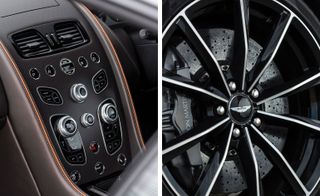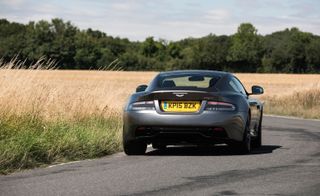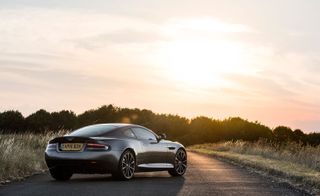End of an era: Aston Martin delivers the DB9 GT
The delivery of the DB9 GT was somewhat bittersweet. Many Aston Martins have passed through our hands over the years but of them all, the DB9 has always been Wallpaper*’s favourite. The new GT is the run-out model of a car that began life in the design studio at the turn of the century, before debuting at the Frankfurt Motor Show in 2003. In its 12-year lifespan the DB9 has evolved in almost every respect – upgraded engine, gearbox, interior, trim, body panels – but it is still the same fundamental machine that wowed the world when it first arrived. Now the line is finally ending.

The delivery of the DB9 GT was somewhat bittersweet. Many Aston Martins have passed through our hands over the years but of them all, the DB9 has always been Wallpaper’s favourite. The new GT is the run-out model of a car that began life in the design studio at the turn of the century, before debuting at the Frankfurt Motor Show in 2003. In its 12-year lifespan the DB9 has evolved in almost every respect – upgraded engine, gearbox, interior, trim, body panels – but it is still the same fundamental machine that wowed the world when it first arrived. Now the line is finally ending.
It says a lot about the essential rightness of those first cars that age has done nothing to dim their visual impact. When it was new, the DB9 was hailed as one of the most beautiful cars ever designed. Created by Ian Callum, lightly enhanced by Henrik Fisker and subsequently overseen by Aston Martin’s current chief creative officer Marek Reichman, the DB9 GT can still lay substantial claim to being the best-looking car you can buy.
Despite its status as an ‘instant classic’ there’s nothing old fashioned about the way the GT drives. The balance, response and feel of this grand tourer has always been second to none and the Aston Martin interior feels like a rich, cosseting embrace, regardless of how many times you get into the car. The DB9 is at its best (as well as its noisiest) with ‘sport ‘ mode selected – turn it off if you want to roll around in a stealthier fashion. The suspension is firm but not uncomfortably so, and the overall ambience is luxurious and smooth. Endless reserves of power are expected and delivered; although unlike its smaller, more aggressive V8 sibling, the DB9 is happier cruising at speed than tearing up tarmac into strips.
There are areas where technology has overtaken this car – in particular, the ergonomics, IT and switchgear all feel rather last generation. And although Aston Martin’s 6.0 litre has been the spiritual and physical heart of the DB9 since the beginning, we’re hoping its prodigious thirst will be somewhat tamed when it’s re-engineered for installation in the forthcoming DB11.
Will that car command the same affection as the evergreen DB9? The outgoing model will leave at the height of its power, gracefully exiting the party before anyone has tired of its presence. The DB11 has a big act to follow.

It says a lot about the essential rightness of those first cars that age has done nothing to dim their visual impact

With its seductive styling, the DB9 GT can still lay substantial claim to being the best-looking car you can buy

The DB9 is at its best (as well as its noisiest) with ‘sport ‘ mode selected – turn it off if you want to roll around in a stealthier fashion

The balance, response and feel of this grand tourer has always been second to none – the Aston Martin interior feels like rich, cosseting embrace, regardless of how many times you get into the car

The outgoing model will leave at the height of its power, gracefully exiting the party before anyone has tired of its presence – the DB11 has a big act to follow
INFORMATION
Wallpaper* Newsletter
Receive our daily digest of inspiration, escapism and design stories from around the world direct to your inbox
From £125,050. For more information, visit Aston Martin
Jonathan Bell has written for Wallpaper* magazine since 1999, covering everything from architecture and transport design to books, tech and graphic design. He is now the magazine’s Transport and Technology Editor. Jonathan has written and edited 15 books, including Concept Car Design, 21st Century House, and The New Modern House. He is also the host of Wallpaper’s first podcast.
-
 Pininfarina Battista Reversario is a new one-off electric hypercar
Pininfarina Battista Reversario is a new one-off electric hypercarThe all-electric Pininfarina Battista Reversario is joining its aesthetic inverse in an ultra-select car collector’s garage. We take a look at a car built to a very precise order
By Jonathan Bell Published
-
 Fernando Jorge’s fluid diamond earrings show his curve appeal
Fernando Jorge’s fluid diamond earrings show his curve appealDiscover Brazilian jewellery designer Fernando Jorge's snake-like silhouettes and graphic shapes
By Hannah Silver Published
-
 Abreham Brioschi debuts Ethiopia-inspired rugs for Nodus
Abreham Brioschi debuts Ethiopia-inspired rugs for NodusAbreham Brioschi teams up with luxury rug experts Nodus to translate visions from his heritage into a tactile reality
By Ifeoluwa Adedeji Published
-
 New Aston Martin Ginza showroom brings customer personalisation to life
New Aston Martin Ginza showroom brings customer personalisation to lifeAston Martin Ginza showroom is a two-storey space in The Peninsula Tokyo hotel and a new hub for the car maker
By Jonathan Bell Published
-
 Aston Martin Vantage is reshaped and revitalised for a new generation
Aston Martin Vantage is reshaped and revitalised for a new generationThe Aston Martin Vantage is a sports car with an authentic racing heritage, now upgraded and enhanced with new styling and fresh interiors
By Jonathan Bell Published
-
 Year in review: the top 10 cars of 2023, as selected by Wallpaper’s Jonathan Bell
Year in review: the top 10 cars of 2023, as selected by Wallpaper’s Jonathan BellWhat were the best four-wheeled offerings of 2023? Transport editor Jonathan Bell takes us through the year’s most intriguing automobiles
By Jonathan Bell Published
-
 The J.Laverack Aston Martin .1R bicycle is a pedal-powered, two-wheeled hypercar
The J.Laverack Aston Martin .1R bicycle is a pedal-powered, two-wheeled hypercarAston Martin and J.Laverack reveal their exquisitely crafted road bike
By Jonathan Bell Published
-
 Zoute Grand Prix is a car fest like no other at a pristine Belgian beachside town
Zoute Grand Prix is a car fest like no other at a pristine Belgian beachside townAmy Serafin takes to the well-heeled streets of Knokke-Heist to experience the Zoute Grand Prix, its annual cavalcade of classic car-related events, from a rally to an auction
By Amy Serafin Published
-
 Aston Martin Valour celebrates 110 years of the British sports car manufacturer
Aston Martin Valour celebrates 110 years of the British sports car manufacturerUnashamedly macho, the limited-edition Aston Martin Valour is a birthday gift for moneyed enthusiasts of old-school driving sensations
By Jonathan Bell Published
-
 The Little Car Company’s garage of pocket exotics are small, speedy and beautiful
The Little Car Company’s garage of pocket exotics are small, speedy and beautifulThe Little Car Company specialises in bespoke ‘junior classics’, exacting, scaled-down reinterpretations of iconic (and expensive) automobiles injected with electric driving delight
By Jonathan Bell Published
-
 Aston Martin’s Q New York showroom blends classic modernism with cutting-edge technology
Aston Martin’s Q New York showroom blends classic modernism with cutting-edge technologyQ New York is an invite-only space on Park Avenue, Aston Martin’s latest foothold in the American market
By Jonathan Bell Published